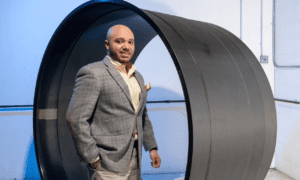In this exclusive TechBullion interview, Hiroshi Nishijima, CEO of Zoomcar Holdings, Inc. (NASDAQ: ZCAR), discusses his leadership journey, strategic vision, and the transformation of India’s largest self-drive car-sharing marketplace. Nishijima, who joined Zoomcar as COO in 2022 before becoming CEO in 2024, brings over 25 years of experience in the global automotive industry. His background includes leadership roles at Grab Holdings Ltd., Via Mobility Japan, and a tenure as Principal at Boston Consulting Group. He holds a degree from Keio University and attended Aoyama Business School.
Under his leadership, Zoomcar has shifted its focus from short-term marketing-driven growth to sustainable, customer-centric expansion. The company leverages AI and data science to enhance user experience, secure transactions, and optimize car-sharing logistics. Unlike traditional car rental services, Zoomcar operates an asset-light model, empowering Hosts to earn income by renting out their vehicles while providing Guests with an affordable alternative to car ownership.
Looking ahead, Nishijima foresees a growing shift toward self-drive rentals, driven by rising driver costs and changing mobility preferences. With its first-mover advantage, tech-driven approach, and expanding partnerships, Zoomcar is well-positioned to lead India’s evolving car-sharing market.
Please tell us more about your background and your role at Zoomcar (NASDAQ: ZCAR). What are the biggest strategic shifts you’ve implemented since taking the helm as CEO in 2024?
I am a big fan of automotives; I’m an automotive guy! My experience over the last 25 years has been in the global automotive industry. During the last 10 years, I have focused on mobility marketplace business. I joined Zoomcar in 2022 as COO and have taken on the role of CEO since June 2024.
The biggest strategic shift was changing how we think about growth. Previously, we thought we could engineer the growth of the business by investing in marketing and incentives, as well as implementing growth-hack product solutions (e.g. small enhancements rather than large changes). We had to rethink this, and come up with a longer term strategy around how to create sustainable growth. The shift we made in June 2024 was to focus on improving the customer experience and take bigger bets, rather than focusing on small enhancements that only led to short-term gains.
What inspired the creation of Zoomcar, what does the company do? How does the platform leverage technology to redefine car-sharing, empowering vehicle owners while providing renters (–> Guests) with a seamless and affordable mobility solution?
The business was started 13 years ago as an asset heavy self-drive rental car business. Over the last decade, there have been so many changes, between technology to consumer preferences and how they travel. We saw this shift coming, and that’s when I joined the Company as Chief Operating Officer, to start the transformation of the business moving from asset heavy to asset light. Today, we’re India’s largest marketplace for self-drive cars. Self-drive meaning non-chauffeured vehicles, where chauffeured vehicles are a common mode of transportation in India. Our platform connects Hosts, who list their vehicles on our platform, to Guests, who are looking for vehicles to rent at affordable prices.
Marketplace companies like us are required to provide a wide range of technologies to serve both supply side customers (in our case, Hosts) and demand side customers (Guests) in order to stay competitive. We prioritize our engineering resources based on how we define what is core for us to ensure a seamless and positive customer experience. Our core technology focus areas are (i) increasing the quantity and improving quality of Hosts and (ii) displaying the best available cars for Guests, tailored to their preferences. We also leverage Gen AI solutions where we can. Our in-house data science teams are building a capability to provide answers to frequently asked customer queries. These tools help us in a variety of ways, from supporting our call center agents to Host acquisition. And because of the technology we’re building, we’re able to provide high quality service while being lean, operating with fewer than 150 employees.
What makes Zoomcar different from traditional car rental services? Can you highlight some of the key features that set your platform apart and provide unique benefits to both car owners and renters?
For most vehicle owners, we probably use our cars to get to and from work, maybe we take trips to the grocery store, or do something fun for a few hours with the family on the weekend. Our cars are sitting idle for the majority of the week. Zoomcar offers an opportunity to our Hosts to make additional income during that idle time. The benefit to Hosts can be significant in terms of side income, and in many cases, we offer a material uplift to Host’s incomes (from their day jobs). By placing their vehicles on our platform, it’s not uncommon to see Hosts who are generating an additional 15-20% of income, which is net of car maintenance and insurance. As a result, we’re seeing more and more entrepreneurs starting their own small businesses by leasing multiple vehicles to be placed on the Zoomcar platform.
For Guests, the problem in India is car affordability. If you take the most popular vehicle purchased in India, the Suzuki Swift, it costs more than USD $10,000. For a population that earns on average USD $2,700 per year, this means the cost of a car can be 3-4x a year’s income. When you compare this to the US, where the average car price to GDP per capita is 0.7x, it’s no wonder why there are only 1 in 10 households who own a vehicle in India, whereas on average in the US, each household has 2 or more vehicles. So cars are expensive to own and maintain, but people still want the experience of owning a vehicle, and being able to drive a car in India is very aspirational.
We are very different from the traditional car rental companies in that we operate an online marketplace and do not own the asset list on our platform. We offer a unique opportunity for Hosts to earn additional side income. No rental car companies have the same level of available inventory like us, especially in the variety of car models, decentralized locations, etc.
One of the challenges with peer-to-peer car sharing is ensuring a seamless and trustworthy experience for both car owners (–> Host) and renters (–> Guest). How does Zoomcar leverage technology and user-friendly features to make car-sharing easy, secure, and accessible for everyone?
We build security features into the app, including selfie authentication at the time of registration and there is an onsite verification process at the booking location. We can track the vehicle locations. And for Guests who are bad actors, we blacklist them from the platform.
We also get a sense for who our Guests are based on their activity. We can regularly check how often users are logging in, and how many minutes they interact with the app. We get a sense for what vehicles are appealing to Guests, based on how they’re scrolling through the screen and how many taps they make while on the app. Based on the user behavior, we’re able to tailor the experience to their liking. In addition, we conduct regular user surveys (both online and in person) for both Guests and Hosts. For Hosts, we hold regular meetups where we invite 20-30 of our top hosts in each of the major cities to share our ideas on new products and get their insights and inputs on how we can improve. And we’re constantly thinking about innovative ways to improve Guest and Host experiences to retain them on our platform.
How does Zoomcar plan to grow its user base and attract more car owners to the platform? Are there any incentives or partnerships that play a key role?
In the past, we used to offer large incentives to both Hosts and Guests. However, in more recent quarters, we’ve been able to grow bookings while reducing our incentives at the same time, and this has led us to achieve five consecutive quarters of positive contribution profit.
In the early stages of operating the marketplace model, the spend was in part to acquire more supply of vehicles on our platform and to reach the density of vehicles we wanted so that Guests had a wider selection to choose from. But in the last year, we’ve pivoted our strategy to focusing on the customer experience. It sounds simple, but by focusing on the experience, whether that is better customer service, or learning our Guests preferences for vehicles over time and making it easy for them to choose by showing them a preferred selection of vehicles at the very top of the list, we see our customers coming back again and again. We are using technology to drive much of this improvement in the experience, and as a result, we see Host retention as well as Guest repeat usage improve, which not only means greater bookings on our platform, but also significant opportunities to optimize costs.
How do you envision the role of technology in the future of car-sharing and mobility? Are there any trends or developments in the technology, automotive or mobility space that you are particularly excited about?
One trend we’re excited about is the rise of Gen AI and how it’s being used more and more for customers in their decision making. To provide an example, historically users of e-commerce companies and even marketplace companies, like us, looked to other user reviews to help them make purchasing decisions. But it takes a significant amount of time to read through reviews (e.g. we have cars with more than 100 reviews and some are lengthy, upwards of 500 words!) and customers want the punchline. So we see many companies starting to use AI to summarize customer reviews, so that there is a concise and short summary to read instead.
With consumer habits changing, we also need to adapt to cater to these changes. We expect that over time, Guests may want to type their queries to help them choose a vehicle on our platform, for example, “I want to travel from Bangalore to Mysole with two friends on a two day holiday. What car would you recommend?”. Then the Zoomcar app, through gen AI features, is able to list a number of available vehicles that fit the criteria. What this means is that marketplace companies like us will have more and more influence over user purchase decisions, and hence our responsibilities will increase in ensuring there is integrity and privacy protection on the app, and that we’re investing in the right technology to support this. This is a very exciting trend.
Zoomcar has successfully raised capital to fuel expansion. How have these investments strengthened the company’s balance sheet and accelerated growth?
We’ve been fortunate to have supportive shareholders who share our vision and have continued to support our funding needs by participating in a recent funding round. While we are confident in our ability to grow organically, procuring additional funding enables us to invest into engineering and technology, which accelerates the timeline for growth.
What should investors know about Zoomcar’s revenue model and long-term profitability strategy? How do you balance growth with financial sustainability?
Our unit economics are strong. Our contribution profit this past quarter has reached an all time high, and contribution margin is over 50%. Over the past year, by pivoting our focus to improving the customer experience, not only have we been able to improve user stickiness and host retention, we’ve also been able to optimize marketing spend, which along with other cost savings initiatives, have led us to achieve record contribution profit levels, which we believe are sustainable going forward. Because our unit economics are strong, we’re also able to focus on growth. So for every incremental booking on our platform, we’re generating US$12.39 in contribution profit, and by increasing our bookings, over time we expect additional profits we’re generating to cover our overhead, driving our business towards profitability on a consolidated basis. We’ll continue to optimize our cost structure while focusing our efforts on growing supply and the top line.
The debt restructuring exercise we’re currently going through is also important to financial sustainability. We’re in discussions with our debt partners to explore various options that include extending the paydown schedules or settling in cash for substantial debt forgiveness, all of which reduces the cash burden and increases sustainability of our balance sheet.
Can you talk about your growth plans?
A key driver of growth is unlocking supply. The demand is there, and we know this because there aren’t enough vehicles on the road to meet the booking demand of our customers. We primarily grow supply through our own sales teams on the ground. Last August we launched our first fulfilment center, where Hosts can bring their cars to be cleaned and maintained in between bookings. For many Hosts who don’t want to manage the logistics of having their cars maintained and meeting Guests to provide the keys, our fulfilment centers can help facilitate all of these logistics on behalf of Hosts. We believe these value-add services are what attract many Hosts to our platform. We also partner with other fleet operators to increase supply on our platform. We’re currently in discussions with a few large rental operators who have the ability to add a significant number of vehicles to our supply.
Where do you see Zoomcar in five years, and what excites you most about the company’s future?
I think we’re starting to see a shift from chauffeured rental cars to more self-driving, especially as the cost for drivers increases. We see a shift in consumer behavior, where people are consuming everyday necessities, for example takeout food or their groceries, via apps where their items are delivered by a driver. We anticipate that in the next 5-10 years, the costs for drivers will increase by several fold, and as a result we expect to see self-driving becoming a much more economical transportation option. With our first mover advantage, our expertise, and the barriers for a new entrant to compete with us at scale, Zoomcar is well positioned to succeed in this evolving mobility landscape.































